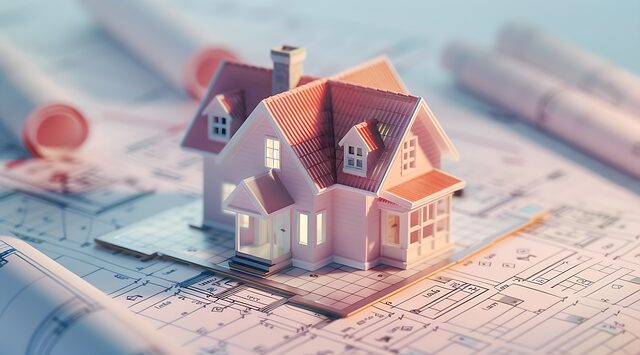Creating a disaster-proof home involves integrating weather-resistant features that enhance structural integrity and safety during extreme storms. Key solutions include impact-resistant panels, surge protectors, storm-rated windows, efficient drainage systems, securing furniture, and installing safe rooms. Using materials like fiber cement siding, high-grade steel doors, and reinforced roofing ensures longevity and fire protection. Smart technology integrations provide real-time weather forecasting alerts and automated safety features. Regular maintenance, including gutter cleaning and window sealing, prevents water damage and structural issues. Investing in these enhancements offers peace of mind and proactive protection for your home and family.
In today’s world, where extreme weather events are becoming increasingly common, ensuring your home is disaster-proof is more important than ever. This article explores comprehensive solutions for enhancing your home’s resilience against harsh weather conditions. From understanding the significance of weather-resistant features to choosing robust materials and integrating smart technology, we guide you through key areas crucial for a safe and durable abode. Discover practical maintenance tips to safeguard your property year-round.
- Understanding Weather-Resistant Home Enhancements: Why It Matters
- Key Areas to Focus On for Disaster-Proofing Your Home
- Choosing the Right Materials for Ultimate Durability and Protection
- Smart Technology Integrations for Advanced Storm Safety
- Maintenance Tips for Longevity: Keeping Your Home Safe Through All Seasons
Understanding Weather-Resistant Home Enhancements: Why It Matters

Creating a disaster-proof home is an essential step in safeguarding your family and investments, especially considering the increasing frequency and intensity of natural disasters globally. Weather-resistant home enhancements are not just about withstanding harsh weather conditions; they actively contribute to the overall safety and resilience of your residence. By integrating these features, you’re better prepared to navigate extreme storms, high winds, heavy rainfall, and other climactic challenges.
These enhancements go beyond typical home improvements, focusing on structural integrity, roofing solutions, window protection, and robust construction materials. For instance, reinforcing exterior walls with impact-resistant panels or installing surge protectors can mitigate the risk of property damage during severe weather events. Additionally, upgrading to storm-rated windows and doors ensures a secure barrier against flying debris, while an efficient drainage system helps prevent water damage from heavy rains. Investing in these weather-resilient upgrades is a proactive approach to safeguarding your home and ensuring peace of mind.
Key Areas to Focus On for Disaster-Proofing Your Home

When disaster-proofing your home, focus on key areas that are particularly vulnerable to weather events and other natural disasters. One of the most critical zones is the exterior, especially the roof and windows. Ensure your roofing material is strong enough to withstand high winds and heavy rain by opting for impact-resistant shingles or tiles. Windows should be double-glazed or made from shatter-proof glass to minimize damage from flying debris.
Internally, pay close attention to electrical systems and plumbing. Upgrading to storm-rated doors and reinforcing exterior walls can significantly improve your home’s resilience. Additionally, securing heavy furniture and appliances against walls can help prevent them from becoming projectiles during severe weather. Remember that a disaster-proof home isn’t just about resistance; it’s also about preparedness, so consider installing a safe room or emergency shelter for added protection and peace of mind.
Choosing the Right Materials for Ultimate Durability and Protection

When enhancing your home to make it disaster-proof, selecting the appropriate materials is paramount for ensuring long-lasting durability and protection against the elements. Weather-resistant options like impact-resilient windows, high-grade steel doors, and reinforced roofing are strategic investments that can significantly mitigate damage from storms, hurricanes, or other severe weather events. These materials are designed to withstand intense conditions, providing peace of mind and safeguarding your property.
Considered for their exceptional strength and longevity, fiber cement siding, concrete, and brick also offer superior defense against wind, rain, and fire. Such materials not only enhance your home’s structural integrity but also contribute to its aesthetic appeal, ensuring that your disaster-proof abode stands strong through any challenge Mother Nature throws its way.
Smart Technology Integrations for Advanced Storm Safety

In today’s digital era, smart technology integrations offer unparalleled advancements in storm safety for a disaster-proof home. From weather forecasting systems that provide real-time alerts and updates to automated shutter systems designed to protect against flying debris, these innovations enhance structural integrity and ensure occupant safety during severe weather events.
For instance, integrated security cameras with motion sensors can detect unusual activity, triggering alarms that notify homeowners and emergency contacts. Additionally, smart lighting systems that adjust brightness based on external light conditions or automatic temperature controls that maintain optimal levels contribute to a resilient living environment, minimizing potential damage from power surges and extreme weather fluctuations.
Maintenance Tips for Longevity: Keeping Your Home Safe Through All Seasons

Regular maintenance is key to ensuring your home remains weather-resistant and disaster-proof year-round. A well-maintained exterior, from checking and repairing gutters to sealing windows and doors, can prevent water damage and reduce the risk of structural issues caused by extreme weather conditions. Regular inspections allow you to identify vulnerabilities before they become serious problems during storms or heavy snowfalls.
Additionally, consider investing in high-quality, durable materials for any enhancements you make. Using weather-resistant siding, robust windows, and strong roofing can significantly improve your home’s resilience against harsh conditions. Keeping up with routine upkeep and choosing the right products will contribute to a disaster-proof home that stands strong through every season.
In conclusion, equipping your home with weather-resistant enhancements is a proactive step towards creating a disaster-proof sanctuary. By understanding crucial areas like roofing, windows, and exterior cladding, selecting robust materials, integrating smart technology, and implementing regular maintenance, you can significantly boost your home’s resilience against harsh weather conditions. These measures not only safeguard your property but also provide peace of mind, ensuring your safety and comfort throughout every season.
